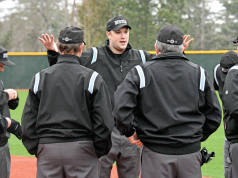There are close plays all over a baseball field and in every game. Half-steppers at first base. Fingertips on stolen base attempts. Pitches at or just below the knees throughout the game.
But nothing gets (or deserves) the amount of attention, anticipation and excitement of a play at the plate.
Proper positioning and mechanics that govern plays at the plate will keep you from a bad result when all eyes are upon you.
Proper Positioning
Some umpires firmly believe in taking plays at the plate from a set location, whether it is the third-base line extended or the first-base line extended. Both positions have faults, however.
From the third-base line extended, you can’t see a swipe tag on the runner’s backside. And from the first-base line extended, you can get blocked out and not see if the runner reached the plate, especially if he cuts to the inside.
Because a play can develop from a wide variety of angles, the best place to start is just off the dirt circle and directly behind the point of the plate. That gives you the option to read the throw and adjust accordingly. Stay along the outside of the dirt circle so that you keep your field of vision wide. You may end up along one of the foul lines extended, or you could possibly circle all the way around and end up in fair territory.
One thing you’ll have to be ready for is previous runners, the on-deck batter and the pitcher getting in your way. Use your voice to keep them clear, but also be aware they can be guilty of obstruction or interference.
No matter how you adjust and move to get the best angle, you should still be stopped and set for the play when it happens. Being set, however, does not mean dropping to one knee. That traps you and gives you little opportunity to move or react to a bad throw or a runner’s sudden movement.
Mechanics
There are two specific things you need to be aware of when it comes to your mechanics of making the call — timing and the runner actually touching the plate.
Even though everyone is waiting with more anticipation than normal considering the magnitude of the play, there is no need for you to rush.
A good technique is to call the runner safe as soon as you determine that he is, but to ensure that you see the ball — “Show me the ball!” — before you call an out. More than one umpire has been fooled thinking that an out has occurred at the plate only to find the pitcher chasing the baseball that has gotten away.
The scoring of a run is final, so once you have ruled the runner has met his responsibilities, you can’t turn back. That is why the plate is treated differently than other bases when it comes to the runner missing. If you signal safe, the run has scored. You can’t make that (or any) signal until the runner is either out or has touched the plate.
Yes, that tips off the defense when no signal is made, but the defense isn’t the one who made the mistake of not touching.
What's Your Call? Leave a Comment:
Note: This article is archival in nature. Rules, interpretations, mechanics, philosophies and other information may or may not be correct for the current year.
This article is the copyright of ©Referee Enterprises, Inc., and may not be republished in whole or in part online, in print or in any capacity without expressed written permission from Referee. The article is made available for educational use by individuals.


















